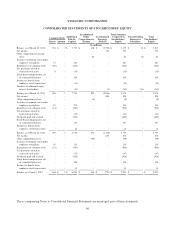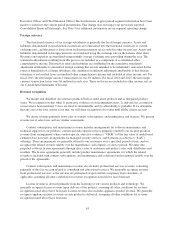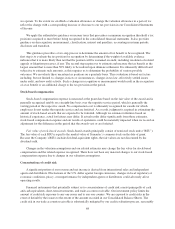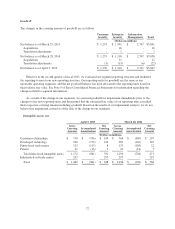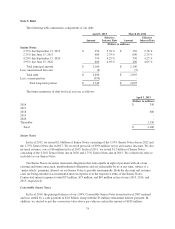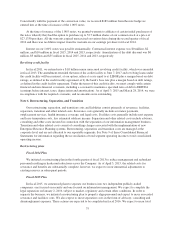Symantec 2015 Annual Report Download - page 147
Download and view the complete annual report
Please find page 147 of the 2015 Symantec annual report below. You can navigate through the pages in the report by either clicking on the pages listed below, or by using the keyword search tool below to find specific information within the annual report.short collection terms, and the geographical dispersion of sales transactions. We maintain reserves for potential
credit losses and such losses have been within management’s expectations. See Note 9 for details of significant
customers.
Advertising and other promotional costs
Advertising and other promotional costs are charged to operations as incurred and included in operating
expenses. These costs totaled $330 million, $451 million, and $594 million for fiscal 2015, 2014, and 2013,
respectively.
Contingencies
We evaluate contingent liabilities including threatened or pending litigation in accordance with the
authoritative guidance on contingencies. We assess the likelihood of any adverse judgments or outcomes from
potential claims or proceedings, as well as potential ranges of probable losses, when the outcomes of the claims
or proceedings are probable and reasonably estimable. A determination of the amount of accrued liabilities
required, if any, for these contingencies is made after the analysis of each separate matter. Because of
uncertainties related to these matters, we base our estimates on the information available at the time of our
assessment. As additional information becomes available, we reassess the potential liability related to our
pending claims and litigation and may revise our estimates. Any revisions in the estimates of potential liabilities
could have a material impact on our operating results and financial position.
Sales Commissions
Sales commissions that are incremental and directly related to customer sales contracts in which revenue is
deferred are accrued and capitalized upon execution of a non-cancelable customer contract, and subsequently
expensed over the term of such contract in proportion to the related future revenue streams. For commission costs
where revenue is recognized, the related commission costs are recorded in the period of revenue recognition.
Recently issued authoritative guidance
On April 10, 2014, the Financial Accounting Standards Board (“FASB”) issued Accounting Standards
Update No. 2014-08, Presentation of Financial Statements and Property, Plant and Equipment, that provides new
guidance related to reporting discontinued operations. This new standard raises the threshold for a disposal to
qualify as a discontinued operation and requires new disclosures of both discontinued operations and certain
other disposals that do not meet the definition of a discontinued operation. The new standard is effective for the
Company April 4, 2015, and will apply to the treatment of the planned separation of our information
management business that is expected to occur on January 2, 2016. Early adoption is permitted but only for
disposals that have not been reported in financial statements previously issued. We do not expect that this
standard will have a material impact on our Consolidated Financial Statements and related disclosures.
On May 28, 2014, the FASB issued Accounting Standards Update No. 2014-09, Revenue from Contracts
with Customers, that requires an entity to recognize the amount of revenue to which it expects to be entitled for
the transfer of promised goods or services to customers, and will replace most existing revenue recognition
guidance in U.S. GAAP. The new standard is effective for the Company April 1, 2017. The standard permits the
use of either the retrospective or cumulative effect transition method. On April 29, 2015, the FASB proposed a
one year deferral in the effective date of the new standard. We are evaluating the effect that the standard will
have on our Consolidated Financial Statements and related disclosures. We have not yet selected a transition
method nor have we determined the effect of the standard on our ongoing financial reporting.
On April 7, 2015, the FASB issued Accounting Standards Update No. 2015-03, Interest-Imputation of
Interest, which requires debt issuance costs to be presented as a direct deduction from the carrying amount of the
69



